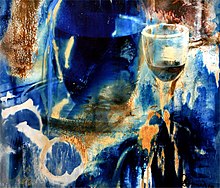
Josef H. Neumann (born May 27, 1953) is a German Art Photographer, media designer and art historian. He invented the chemogram, an experimental artform involving manipulating chemicals in film photography.

Josef H. Neumann (born May 27, 1953) is a German Art Photographer, media designer and art historian. He invented the chemogram, an experimental artform involving manipulating chemicals in film photography.
Josef H. Neumann completed an apprenticeship as a photographer under Gustav Wenningin his birthplace of Rheine in Westphalia from 1967 to 1970. From 1974 to 1978 he studied visual communication at the Dortmund University of Applied Sciences under Professors Pan Walther (photographer) and Adolf Clemens (photojournalist). After completing his diploma as a photo designer under Professor Harald Mante (photo designer) in the Department of Photography/Film Design (1979), he completed his studies in journalism, philosophy and art history at the Westphalian Wilhelms University in Münster with an intermediate diploma in 1984 under Professors Winfried B. Lerg (publicist), Hans Blumenberg (philosopher) and Georg Kauffmann (art historian).
Neumann married in 1991 the teacher and kindergarten director Martina Flügel. The marriage was dissolved in the year of 2003. He is married with the Physiotherapista and Venezuelana Verónica Cristina López Pérez, since March 27, 2020 in Moche, Trujillo, Peru. They live separately since 2022 in Santiago de Chile and Dortmund, Germany.
Since 1979 Neumann lectured at intervals at the Dortmund University of Applied Sciences and Arts in the fields photo design and social work. He also had an assignment for Designing with Electronic Media ("Gestaltung mit elektronischen Medien") with the department of computer science of the Dortmund University of Applied Sciences and Arts for 20 years.

Since 1986 Neumann photographed for various publishing houses in Germany, Austria, France and Switzerland. Neumann mainly worked for the publisher C. J. Bucher (Munich) while often using the Russian panorama camera Horizont. Several panorama illustrated books were published, including Paris, Vienna, Switzerland, Munich, Germany, Tuscany und Sicily.
His illustrated book Deutschland was awarded twice – in the years 1987 and 1990 – with the Kodak-Fotobuchpreis. In addition, this book has a preface by president Richard von Weizsäcker and was published with an edition of more than 40.000 copies. As the German government has given one copy as a present to each host for several years the book has a worldwide spread.

While having an academic status at the Dortmund University of Applied Sciences and Arts in the department of design from 1986 to 1987 Neumann wrote two standard references Filme kreativ nutzen (Using films creatively) and Objektive kreativ nutzen (Using lenses creatively) together with Harald Mante in 1986 and 1988.
1993 Neumann lectured at the former Fachhochschule Köln (now Technical University of Cologne) in the department of photo engineering.
After intensive and creative research in the new camera generation Zoom-Kompakte his book Zoomkompakte kreativ was published in 1994 on occasion of the 75th anniversary of the Japanese camera company Asahi Optical Joint Stock Co. alias Pentax.
In his hometown of Dortmund, Neumann photographed together with Gerhard P. Müller under the leadership of the text authors Wolfgang Rinke and Dore Bolege-Vieweg for the book titles Dortmund Churches of the Middle Ages and Dortmund Village Churches, two extensive illustrated books on Dortmund church treasures, which were published by Verlag Fr.-W. Ruhfus in 1987 and 1999.
Since 2003 Neumann has artistically worked at intervals in Portugal (Algarve) on photo and video productions.
Josef H. Neumann is a member of the German Society for Photography (DGPh) since 1986th
Im Januar 2012 he opened his atelier INICIO.de together with the Agentinian artist Virginia Novarin in the Unionviertel in Dortmund.
Today Neumann works as freelancing photo designer producing image and product commercials for print and video. In addition Neumann regularly works as lecturer on didactic methods of photography for public institutions and private companies.
Neumann published for all major German photographic journals like Color Foto, Foto, Fotoheft, Fotomagazin, Minolta Mirror, Nikon News, Photo, Photographie, Photo Revue, Professional Camera, ProfiFoto, fineartphotomagazine. His photographs have been used in numerous German and European publications wow Creative Photography , Relais & Châteaux , Brigitte , Natur , Freizeit Revue , S.Fischer Verlag , Suhrkamp Verlag and Time .
From 1981 to 1996 Neumann was member of the editorial team of the German magazine Photographie in Düsseldorf and Zürich.
At the same time Neumann was chief editor of the German magazine Fotoheft from 1990 to 1992. [1]


1974 Experimental advancements of Chemigrams to Chemograms, [2] in which photographic images are first processed onto photographic paper and then chemicals are additionally applied onto it [3] [4] [5]
1976 First successful tests in producing "edible photo prints" using screen printing and coinage of the term
1992 Foundation of the company FOTOMeDIA and research with focus on electronic processing of pictures for multimedia projects.
1993 DIPO DIGITAL POSTCARD Development, registration at the DPMA and marketing of the first DIPO DIGITAL POSTCARD on disk [6]
1998 Completion of research (begun in 1976) regarding the production of "edible photo prints" using piezotechnology and food colors. [7] [8] [9]

As part of his teaching activities at the Dortmund University of Applied Sciences, Department of Design, in the years 1981-1986 and the Dortmund University of Applied Sciences, Department of General Computer Science, from winter semester 1996 to today, summer semester 2025, in the subject *Design with electronic media*, Josef H. Neumann opened in December 2000 with his students, led by Stephan Rosegger, within a Pilot project, in cooperation with the engineering company ICN.de, the first Internet Gallery on the World Wide Web. [10] [11] [12]
mit Co Autor Harald Mante
